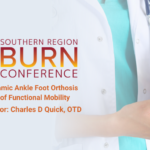Abstract | December 20, 2021
Adjustable Dynamic Ankle Foot Orthosis for Recovery of Functional Mobility
Learning Objectives
- Describe the benefits of a custom, dynamic adjustable ankle foot orthosis with a medically complex patient who demonstrated significantly limited ankle dorsiflexion.
Introduction:
We present a case of a 23-year-old woman with primary-onset peroneal nerve impairment following diagnosis of purpura fulminans involving 30% total body surface area, who was treated in our burn center. Medical complexity required a unique rehabilitation intervention. The purpose of this case study is to demonstrate the effectiveness of a dynamic ankle-foot orthosis (AFO) to recover functional ambulation.
Methods:
Upon initial evaluation and during weekly re-evaluations, a physical therapist (PT) and an occupational therapist (OT) measured active range of motion (AROM), passive range of motion (PROM), and strength. Absent to trace common peroneal nerve function was identified bilaterally 8 days after admission. The patient underwent 41 surgeries and spent 231 days in the burn intensive care unit. She experienced 3 episodes of acute respiratory distress syndrome and septic shock, acute renal failure requiring 150 days of continuous renal replacement therapy, and 51 ventilator days. Due to post-operative restrictions and/or medical complications, lower-extremity ROM was restricted for 63 days and supine position was restricted for 49 days. Rehabilitation interventions included PROM, AROM and continuous passive motion. Weight-bearing activities included use of a tilt table, Moveo exercise platform, and standing frame; transfer training; and gait training with a rolling walker (RW). Positional interventions included sitting in a Total Lift Chair, serial casting, and custom AFO fabrication.
Results:
On hospital day 215 the patient ambulated 15 feet using a platform walker and required assistance of 4 staff to support the ankle and foot. On hospital day 229, static custom AFOs were implemented and the patient ambulated 325 feet with contact guard assist (CGA). The static AFOs required frequent re-fabrication due to daily ROM progress. Adjustable dynamic AFOs were fabricated to decrease resource burden. With the dynamic AFOs, the patient progressed to 745 feet CGA on hospital day 258. The patient discharged to an acute rehabilitation center on hospital day 260.
Conclusions:
Extensive medical, surgical and positional restrictions required innovative interventions by a multidisciplinary team. This resulted in the fabrication of dynamic custom AFOs for gait training. Utilization of these AFOs significantly increased activity tolerance and ambulation distance, and enabled eventual discharge to a rehabilitation center.

